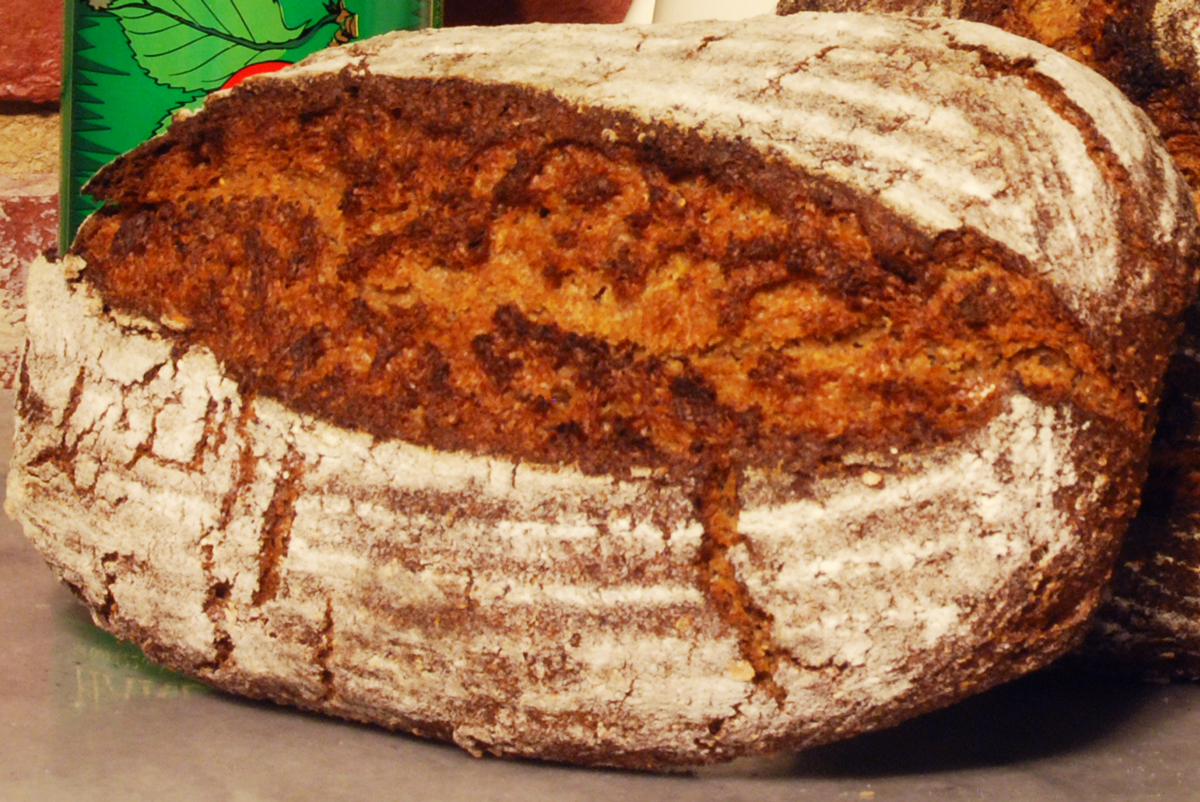 After reading about how much better freshly ground flour is compared to store-bought I finally decided to wiggle a couple of toes in the water and try grinding some of my own. I used my Krupps coffee grinder to make some Farro flour and also some Hard Red Wheat from grains I had purchased at Whole Foods previously.
After reading about how much better freshly ground flour is compared to store-bought I finally decided to wiggle a couple of toes in the water and try grinding some of my own. I used my Krupps coffee grinder to make some Farro flour and also some Hard Red Wheat from grains I had purchased at Whole Foods previously.
To make it interesting I used a portion of my standard AP starter along with a much larger portion of a Farro starter I prepared.
I didn't have enough whole grains to grind all my own flour so I used King Arthur flour for the rest of the ingredients.
I also made a soaker using some cracked wheat.
I have to say I made a mistake by thinking the extra liquid from the soaker would increase the hydration of the dough which only comes in at 57%. Since the freshly milled flour also sucks up more water than store-bought the final dough ended up much drier than I would have liked and the crumb was denser than my usual multi-grain bakes. Next time I will increase the liquid amount probably another 15-20%.
I think I shall have to invest in an attachment for my wife's Kitchen Aid to mill my own flour which should be much easier to do larger batches than the Krupps.
In any case the final bread while not being one of my favorites still tasted very earthy with a nice sour flavor and nutty undertones from the Farro and Wheat Germ.
Farro Starter
184 grams Farro Flour ground from fresh kernels
71 grams AP Starter
117 grams Water at Room Temperature (80-90 degrees F.)
Mix ingredients in a bowl until thoroughly combined. Cover the bowl and let it sit at room temperature for around 10 hours. The starter should almost double when ready to proceed. You can either mix in final dough or put in refrigerator for at most 1 day before using. If your kitchen is warmer than mine which is usually about 70-72 degrees with my air-conditioning you can proceed sooner.
Soaker
90 grams Cracked Wheat
280 grams Boiling Water
Mix ingredients together in a bowl and cover. Let rest for 30 minutes or longer until ready to use.
Drain the liquid before mixing in the final dough.
Main Dough Ingredients
75 grams Refreshed AP Starter (65% hydration)
351 grams Farro Starter from above (should be all of it)
90 grams Cracked Wheat Soaker from above
75 grams Quinoa Flour
70 grams Wheat Germ
40 grams Potato Flour
200 grams French Style Flour (You can substitute AP flour)
195 grams Freshly Ground Hard Red Wheat Flour
100 grams Pumpernickel Flour (Dark Rye or Course Rye Flour)
50 grams Molasses
16 grams Sea Salt or Table Salt
430 grams Hard Cider
Procedure
Mix the flours with the Hard Cider and molasses in your mixer or by hand for 1 minute. Next cut the starters into small pieces and put in bowl and mix for 1 minute to incorporate all the ingredients. Let the dough autolyse for 20 minutes to an hour in your bowl and make sure to cover it. Next add in the salt, and the soaker and mix on speed #1 for 3 minutes or by hand and on speed #2 for 2 minutes. The dough should have come together in a ball and be tacky but not too sticky.
Next take the dough out of the bowl and place it on your work surface. Do a stretch and fold and rest the dough uncovered for 10 minutes. After the rest do another stretch and fold and cover the dough and let it rest for 10 minutes. Do one more stretch and fold and put the dough into a lightly oiled bowl and let it sit at room temperature covered for 2 hours. After 2 hours you can put the dough into the refrigerator for 24 hours or up to 2 days before baking. Feel free to do some additional S & F's if you feel it is necessary. I baked the bread about 24 hours later.
The next day (or when ready to bake) let the dough sit out at room temperature for 1.5 - 2 hours. Next, form the dough into your desired shape and put them in floured bannetons, bowls or on a baking sheet and let them rise covered for 2 hours or until they pass the poke test. Score the loaves as desired and prepare your oven for baking with steam.
Set your oven for 500 degrees F. at least 30 minutes before ready to bake. When ready to bake place the loaves into your on your oven stone with steam and lower the temperature immediately to 450 degrees. Since these loaves were a little lower in hydration and were not cooking as quickly as normal, I lowered the temperature to 430 degrees. The total baking time was around 45 minutes. When both loaves are golden brown and reached an internal temperature of 200 degrees F. you can remove them from the oven.
Let the loaves cool down for at least an 6 hours or so before eating as desired.
The crust the next day was very hard and the crumb like I said before was much denser than I would have hoped but this bread still makes some nice pastrami or corned beef sandwiches for sure along with a nice sour pickle. Now I have to go get some to eat for lunch!


